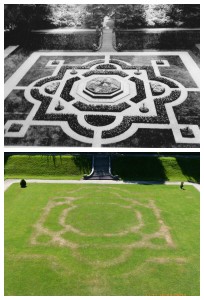In dry and warm summers like these, underlying structures often shine through the otherwise opaque green surface of garden lawns. Robert Greening already knew that in 1752, when he advised that the rich soil of the former parterres in the north garden of Wimpole Hall should be dispersed over and mixed with the rest of the soil as much as possible, before he grassed it over. 1See: M. Laird, The Flowering of the Landscape Garden; English Pleasure Grounds 1720-1800 (Philadelphia 1999), page 120.. Also used in my article on the aesthetics of lawns in 2002: Van der Eijk, H.; ‘Van bloemenweide tot “melancholy lawn”: oorspronkelijke ideaalbeelden als basis voor ontwerp en beheer van gazons in (vroeg-) landschappelijke tuinen.’, Cascade 11 (2002), nr 2, p.25-44 [pdf] (in Dutch).  He also advised to dig out foundations of former buildings to a good depth, “else in the Summer the Grass will burn & shew where each wall was.”
He also advised to dig out foundations of former buildings to a good depth, “else in the Summer the Grass will burn & shew where each wall was.”
Luckily not everybody heeded his words, otherwise we would have missed out on many views that have been posted in the UK the past week. One example from Gawthorpe Hall is striking because it also gave a photo from the situation that was shining through (via @NTGawthorpe ).
I have not yet seen any accounts coming in from the Netherlands. I can’t imagine there are no examples to be found here, our summer has been quite dry over the past month.
Anybody?
Footnotes
| ↑1 | See: M. Laird, The Flowering of the Landscape Garden; English Pleasure Grounds 1720-1800 (Philadelphia 1999), page 120.. Also used in my article on the aesthetics of lawns in 2002: Van der Eijk, H.; ‘Van bloemenweide tot “melancholy lawn”: oorspronkelijke ideaalbeelden als basis voor ontwerp en beheer van gazons in (vroeg-) landschappelijke tuinen.’, Cascade 11 (2002), nr 2, p.25-44 [pdf] (in Dutch). |
|---|




This certainly makes archaeological searches a little easier.
I know it is possible to see buildings foundations also during the sunset
Or sunrise (but I am not a morning-person :-)).
You are right, thanks!
Thanks for sharing!
Regards,
Victoria at Gawthorpe Hall